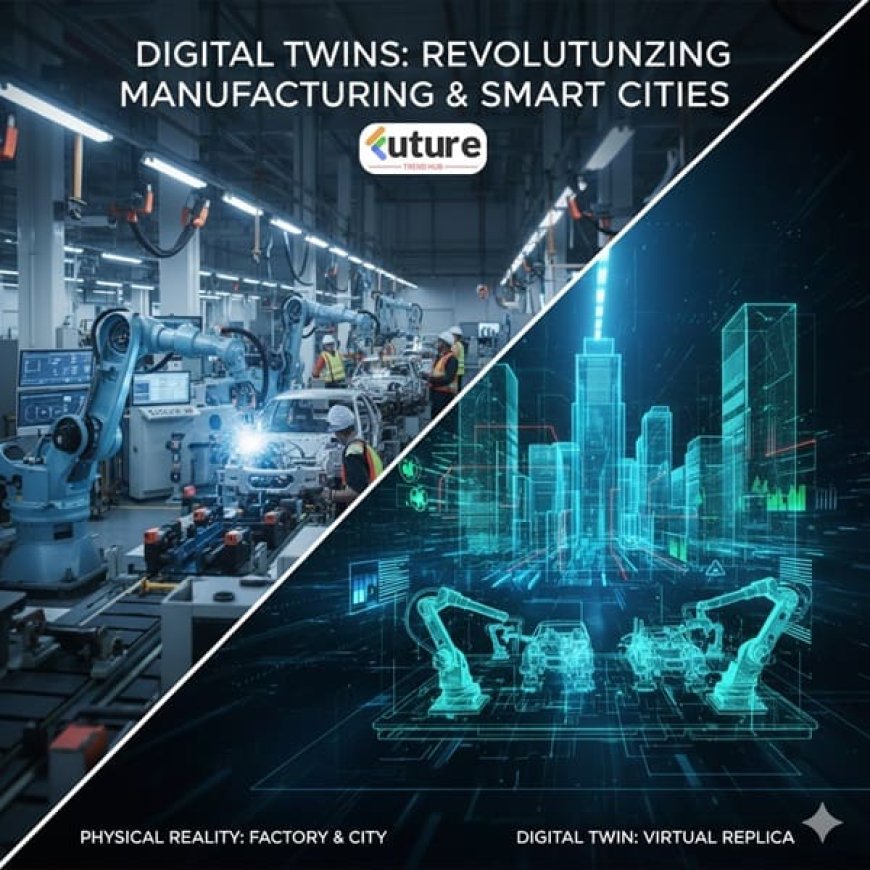Digital Twins: How Virtual Replicas Are Transforming Manufacturing and Smart Cities
Discover how digital twins—virtual replicas powered by AI and IoT—are revolutionizing manufacturing efficiency, smart city planning, and sustainability worldwide.

Digital Twins: How Virtual Replicas Are Revolutionizing Manufacturing and Smart Cities
Introduction
Imagine being able to create a living, breathing digital copy of a machine, a factory, or even an entire city. A version that behaves exactly like the real one — showing how it’s performing, predicting when it might fail, and helping you fix problems before they even happen.
That’s the magic of Digital Twin technology. It’s one of the most exciting innovations driving today’s Industry 4.0 revolution. From smarter factories to intelligent city planning, digital twins are changing the way we build, operate, and maintain everything around us.
What Exactly Is a Digital Twin?
A digital twin is basically a virtual version of a real-world object, process, or system. It continuously receives data from sensors, IoT devices, and machines to mimic real-world behavior in real time.
Think of it as a mirror — but instead of reflecting light, it reflects data and performance.
For example, a car manufacturer can create a digital twin of an engine to test how it reacts under different conditions without ever touching the real engine. Similarly, city planners can build a digital replica of a city to test traffic patterns or flood management before making changes in the real world.
How Digital Twins Are Changing Manufacturing
The manufacturing industry has always been quick to adopt new technologies — and digital twins are proving to be game changers.
With a digital twin, manufacturers can see exactly how their machines are performing, detect issues early, and even test new designs without halting production.
Some real benefits include:
-
Predictive maintenance: Machines rarely break down without warning — digital twins help spot those warning signs early, saving time and money.
-
Process improvement: Factories can simulate different production strategies and choose the one that saves energy, materials, or manpower.
-
Better quality control: Continuous monitoring helps catch product defects early.
-
Sustainability: Less waste, less downtime, and more efficient use of resources make operations greener and more cost-effective.
Take Siemens, for example. By using digital twins in its factories, the company has improved productivity by nearly 20% and cut product development time significantly.
Building Smarter Cities with Digital Twins
Digital twins aren’t just for machines — they’re reshaping how entire cities are planned and managed.
Cities like Singapore and Shanghai have already built virtual replicas that allow planners to simulate urban development, manage utilities, and respond to emergencies more effectively.
Here’s how digital twins make cities smarter:
-
Urban Planning: Authorities can visualize new infrastructure before construction starts.
-
Energy Management: Smart grids powered by digital twins can reduce power loss and optimize supply.
-
Traffic Control: Real-time data helps control congestion and plan better transport routes.
-
Disaster Management: Simulations can predict flood impact or emergency evacuation needs in seconds.
It’s like giving city administrators a control room for the entire city — one where every streetlight, building, and power grid is connected and communicating.
How It All Works
Behind the scenes, a digital twin depends on four key layers:
-
Physical Layer: Sensors and devices on the real-world asset.
-
Data Layer: Information gathered from sensors and IoT systems.
-
Simulation Layer: Software that analyzes and predicts behavior.
-
Visualization Layer: Dashboards or 3D models that humans can interact with.
Artificial Intelligence and machine learning make this entire system “smarter” over time — learning from patterns and improving accuracy with every cycle.
The Challenges Ahead
Of course, no technology comes without challenges.
Digital twins require a strong data infrastructure, skilled people, and robust cybersecurity.
Some common hurdles include:
-
Integrating old systems with modern IoT setups
-
Protecting sensitive industrial data
-
Managing the high initial cost of setup
-
Training teams to handle new digital tools
However, as technology becomes more affordable and 5G networks expand, these challenges are quickly becoming manageable.
The Road Ahead
The future of digital twins looks incredibly promising. Experts predict that by 2030, nearly 70% of large manufacturers and smart cities will use digital twin systems for planning, optimization, and sustainability.
Next-generation digital twins will likely be AI-driven and autonomous, capable of adjusting their own operations in real time. Combine this with edge computing and blockchain, and we’re looking at a future where digital twins make decisions faster, safer, and more transparently than ever before.
Conclusion
Digital twins are not just about creating virtual copies — they’re about creating knowledge.
They help us understand how things work, how they can break, and how to make them better.
Whether it’s reducing downtime in factories or designing eco-friendly cities, digital twins are giving us the ability to predict, prevent, and perfect in ways we couldn’t imagine a decade ago.
It’s safe to say that in the coming years, every major industry and city will have a digital reflection — a smarter version of itself — working silently in the background to make our world more efficient and sustainable.







